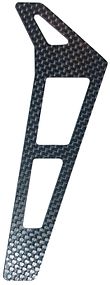
Back بوليمر مدعم بألياف الكربون Arabic Вуглепластыкі Byelorussian Полимер, подсилен с въглеродни влакна Bulgarian Polímer reforçat amb fibra de carboni Catalan Kohlenstofffaserverstärkter Kunststoff German Polímero reforzado con fibra de carbono Spanish Süsinikkiuga tugevdatud polümeerid Estonian پلیمر تقویتشده با الیاف کربن Persian Polymère renforcé de fibres de carbone French Երկաթածխածնային համաձուլվածքներ Armenian

Carbon fiber-reinforced polymers (American English), carbon-fibre-reinforced polymers (Commonwealth English), carbon-fiber-reinforced plastics, carbon-fiber reinforced-thermoplastic (CFRP, CRP, CFRTP), also known as carbon fiber, carbon composite, or just carbon, are extremely strong and light fiber-reinforced plastics that contain carbon fibers. CFRPs can be expensive to produce, but are commonly used wherever high strength-to-weight ratio and stiffness (rigidity) are required, such as aerospace, superstructures of ships, automotive, civil engineering, sports equipment, and an increasing number of consumer and technical applications.[1][2][3][4]
The binding polymer is often a thermoset resin such as epoxy, but other thermoset or thermoplastic polymers, such as polyester, vinyl ester, or nylon, are sometimes used.[4] The properties of the final CFRP product can be affected by the type of additives introduced to the binding matrix (resin). The most common additive is silica, but other additives such as rubber and carbon nanotubes can be used.
Carbon fiber is sometimes referred to as graphite-reinforced polymer or graphite fiber-reinforced polymer (GFRP is less common, as it clashes with glass-(fiber)-reinforced polymer).
- ^ Cite error: The named reference
tool wearwas invoked but never defined (see the help page). - ^ Geier, Norbert; Davim, J. Paulo; Szalay, Tibor (1 October 2019). "Advanced cutting tools and technologies for drilling carbon fibre reinforced polymer (CFRP) composites: A review". Composites Part A: Applied Science and Manufacturing. 125: 105552. doi:10.1016/j.compositesa.2019.105552. hdl:10773/36722.
- ^ Dransfield, Kimberley; Baillie, Caroline; Mai, Yiu-Wing (1 January 1994). "Improving the delamination resistance of CFRP by stitching—a review". Composites Science and Technology. 50 (3): 305–317. doi:10.1016/0266-3538(94)90019-1.
- ^ a b Kudo, Natsuko; Fujita, Ryohei; Oya, Yutaka; Sakai, Takenobu; Nagano, Hosei; Koyanagi, Jun (30 June 2023). "Identification of invisible fatigue damage of thermosetting epoxy resin by non-destructive thermal measurement using entropy generation". Advanced Composite Materials. 33 (2): 233–249. doi:10.1080/09243046.2023.2230687. ISSN 0924-3046.